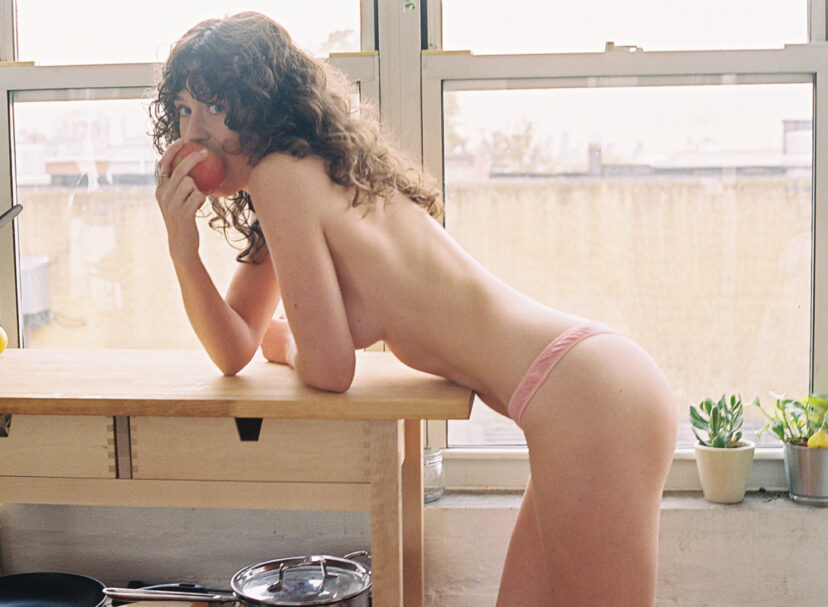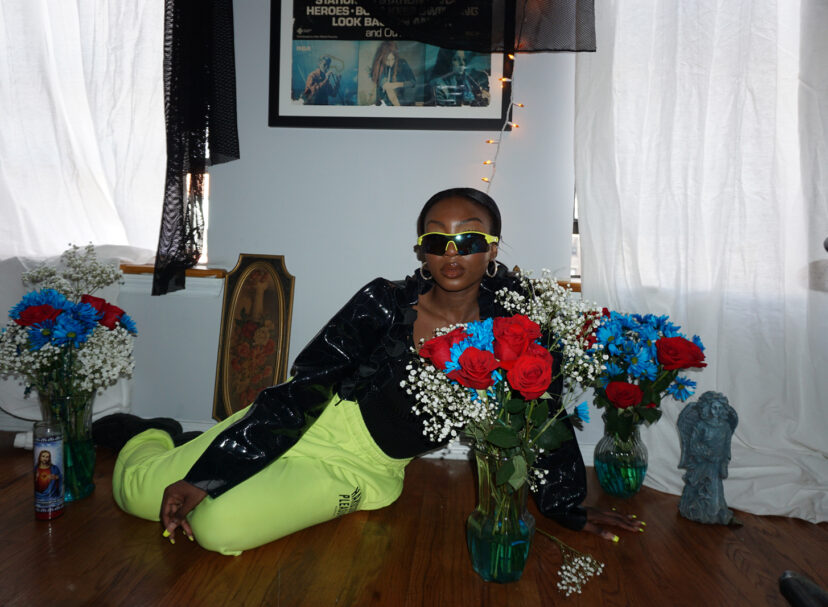Text and Interview: Monica Uszerowicz
Photos: Elisabet Davids

Daryl K (the “K” is for Kerrigan) is synonymous with an especially romanticized period of New York City’s history. In 1991, she opened her East Village store, drawing hip clientele like Kim Gordon; her fashion shows became the stuff of legend, taking place on the flatbeds of trucks, at the bottom of empty swimming pools, in banks, and, as recently as 2012, at Gavin Brown’s Enterprise. Born in Dublin, Ireland, Daryl studied fashion design at the National College of Art and Design, moved to New York City in 1986, and worked on film sets as a costume designer. She barely had experience industry by the time her storied shop opened a few years later–it was her unique vision alone that made it happen.
Daryl’s always focused on genuine style, rather than fashion trends themselves; she’s a sturdy voice in a world that tends to waver. She recently became part of No. 97, a design collaborative and shop, launching both her new Recycle collection (a set of tailored vintage clothes she’s delicately altered) and a collection of custom leather leggings. She’s also created Mothalova, a self-described “call to awareness and to action to care for and protect all life on the planet earth, our Mother.” Like many artists who recognize their creative platform as a space to dedicate to larger issues, Daryl is concerned about sustainability and taking care of the planet. We recently spoke to her about her history, her work, and the future of the earth. What we learned: Daryl is creative, compassionate, steadfast as hell, and is asking for real environmental and sociopolitical consciousness in her industry—not the fleeting trend of casual environmentalism. Thank goodness for that.

I’m not that interested in participating in mass-production fashion in that system any longer. It doesn’t feel right to me, with what’s going on environmentally.


Tell me about your history.
Between the semesters at college, I would come over to New York. In 1986, my final year in college, I stayed. It wasn’t very premeditated; I just kind of came.
I guess you knew you wanted to be there.
New York was just exciting. I’m sure it’s the same for kids arriving here now. It really was different then; I remember American cars back in the ’80s. They were so huge, those big boats, with those big bench seats—you could have four people sitting in the front. How much fun was that? You could be there with the music blasting. And the windows, too. There’d be no bar in between the windows; you could have air from the front driver’s seat all the way to the back.
You worked on movie sets when you first got here, right?
Yeah, I did what a lot of people do when they first come here: worked as a waitress. Then I worked on movie sets for about five years, and eventually opened my own business—my store in the East Village.
Which was iconic.
It was. It was something new. I was lucky—I had an idea and there wasn’t a whole lot going on in New York at the time. There were just a lot of vintage stores, and Charivari uptown, and a few other things, but they didn’t even have Fashion Week yet. It was a very exciting place to develop your persona and your personality and character. There’s a real reason people have that sort of nostalgia for those times.
I grew up watching Style Wars. The nostalgia for New York feels like it’s always for that specific time period, in the 1970s and 1980s.
I arrived on the tail end of what started in the ’60s and ’70s, when cultures were mixing. You’d have the rock-and-roll scene mixing with the uptown scene, the art scene, and even people like Alan Vega, Suicide, the New York Dolls. There was the crossover with the punk scene in London versus the one in New York. All of that happened way before I arrived. You know that concert in Wild Style with Fab 5 Freddy? That band shell? Annie Leibovitz took photos of me, my whole studio crew, and some customers there. It was closed at the time, and we had to hop the fence to get inside. I have a lot of imagery from that time. I should post it.
That was always my inspiration, and it continues to be: the street. Not just what they call “street style” now, with people wearing fashion from H&M and Zara. I mean the street style that people created themselves. That was exciting about New York back then, and what continues to inspire me today. A lot of designers don’t really acknowledge the kids they get that from—maybe Hood By Air does. I find it boring when everybody is wearing the same fashion they’ve all bought from the high street stores. It’s great everyone is into it, but to me, as a designer, I’d much rather look at the kids on the street.


We all have to make these choices. Nobody can stand by and do nothing anymore. We’re all part of this.


I wanted to ask you about your new collection, too, and its inspiration.
Tess Giberson’s old store in now a design collaborative with several women, including Tess, myself, and AWAVEAWAKE. I decided to join, though I haven’t really been in retail since 2012. I really needed a break from it all. What I have in the store—mainly what I produce these days—are leather leggings, and I’m doing some vintage as well. I feel like I’m really vintage myself, at this point—I’m the vintage! I’ve been around for about twenty-five years now. I’ve been making those exact same pants, in stretch leather, since 1999. They’re a complete classic; now that a leather legging exists, they’re never going to go away.
I’m also pulling in these vintage linen smocks, from the 1800s. They’re incredible and all hand-sewn [the Recycle collection]. I might do small little alterations—not to alter them too much, just to adjust the fit. I’m not that interested in participating in mass-production fashion in that system any longer. It doesn’t feel right to me, with what’s going on environmentally. Everything is made to order. It’s all turned around very quickly, so even if you order something online, you get it within a few days. With leather, everything has to be cut individually, anyway. It’s sustainable, too, because it lasts a long time. I love what Vivienne Westwood said recently: “Buy less. Choose well.” These leather leggings last for five or six years.
In addition to these leathers and Recycle, there will be other vintage pieces, but I want to put another label on them and call them Movalova, which is a new idea I had.
I was going to ask you about that! I like that you’ve shifted your focus to sustainability and thinking about the environment.
I feel really strongly about it. I’ve always had an environmental and political slant in what I do. One of the very first things I did, in 1992—there was a big argument going on about women’s abortion rights. I was a club kid back then, so a lot of customers in my little store on 6th Street—I’d get drag queens for whom I made custom dresses; it was very celebratory. I made this hot pink T-shirt with the word “CHOICE” hand-stenciled in thick, silver, glittery writing. It’s relevant again today. It’s about choice in so many things: I choose to be with another woman or another man, I choose to not have children, I choose to recycle, I choose to not use fossil fuels. We all have to make these choices. Nobody can stand by and do nothing anymore. We’re all part of this.
We are all responsible.
It drives me crazy when people don’t recycle. I think that it’s just so shallow to give yourself everything that you need, give yourself the most you could possibly have, without thinking about others. Think about the Dakota Access Pipeline—they’re supporting each other to stay there. Somebody arrived with a truckload of salmon they’d smoked to feed all of the protestors. It is not about money, or how much money we can give ourselves. It’s about something else, and it has to be about that from now on.
There are midwives out there who set up a pre-natal health clinic there.
Wow. There was a time when you’d bring up these issues and no one would want to talk about it. But now everybody is ready to talk: we see it, we feel it. I just watched that old clip of Nina Simone, in which she says that if you’re an artist, you need to comment on the social and political environment around you. If you’re not doing that, what kind of an artist are you? People always want to talk about happiness. It’s great, sure; everyone is into meditation, talking about love, “Love Trumps Hates.” But what is this “love” thing? How are we actually going to express this love? Are we going to do things for each other and show the love, or are we just going to talk about it?
I used to visit Occupy Wall Street quite a lot. I think those people are amazing, putting themselves on the frontlines. I remember marching over the Brooklyn Bridge and I was so surprised to find I was the only person of my “type,” someone into fashion. Nobody else was representing my society, my economic group, and I feel like that’s really missing. I want people to be more involved. I want this to be something that really matters. What are we going to say to our kids in twenty years when it’s a big mess? “What were you doing about it?” they might ask. “What were you saying? Were you caring?”





